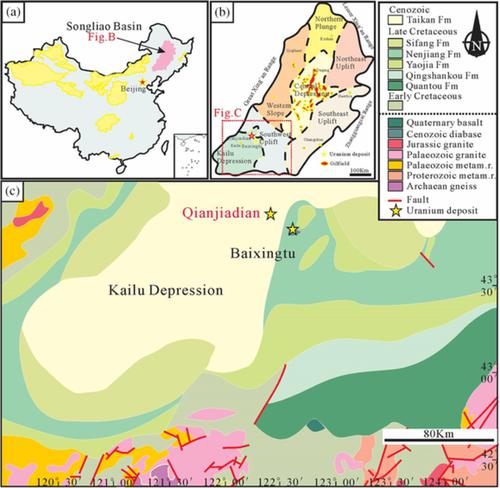当前位置:
X-MOL 学术
›
Resour. Geol.
›
论文详情
Our official English website, www.x-mol.net, welcomes your feedback! (Note: you will need to create a separate account there.)
Characteristics of fluid inclusions in the sandstone-hosted Qianjiadian uranium deposit, southwest Songliao Basin, northeastern China: Implications for the nature and evolution of ore-forming fluids
Resource Geology ( IF 1.4 ) Pub Date : 2021-11-25 , DOI: 10.1111/rge.12281 Xue‐li Ma 1, 2 , Ke‐yong Wang 1 , Ruo‐shi Jin 3 , Jian‐guo Li 3 , Hong‐ying Zhou 3 , He Yang 1
Resource Geology ( IF 1.4 ) Pub Date : 2021-11-25 , DOI: 10.1111/rge.12281 Xue‐li Ma 1, 2 , Ke‐yong Wang 1 , Ruo‐shi Jin 3 , Jian‐guo Li 3 , Hong‐ying Zhou 3 , He Yang 1
Affiliation

|
The Qianjiadian deposit is a typical sandstone-hosted uranium deposit that is hosted mainly in sandstone and siltstone of the Lower Cretaceous Yaojia Formation, located within the transition between the Kailu Depression and Jiamatu Uplift in the Songliao Basin, northeastern China. We studied the geological characteristics of this deposit, and analysed the mineralized sandstone by scanning electron microscopy (SEM) and electron probe microanalysis (EPMA) to identify the host minerals of fluid inclusions associated with uranium mineralization and describe their petrographic characteristics. In addition, this research investigated the origin of ore-forming fluids and the relationship between petroleum fluids and uranium mineralization, based on the following findings. (1) EPMA and SEM data show that uranium minerals are hosted mainly in hydrothermal quartz (HQ) within sandstone cement, which indicates that uranium minerals co-precipitated with HQ. (2) The fluid inclusions in the HQ show low homogenization temperatures (102.5–169.5°C) and low salinities (1.7–6.1 wt%). In contrast, aqueous inclusions in quartz overgrowths show lower temperatures (60.5–117°C) and higher salinities (4.2–8.7 wt%). (3) Petroleum fluids trapped in HQ homogenize fluid and those along healed microfractures in quartz overgrowth or plagioclase overgrowths at ~70–80°C, those trapped in present-day organic inclusions at ~85–95°C, and at the boundary of detrital mineral grains show higher homogenization temperatures (~135–145°C). These results indicate that the hydrothermal quartz cement is associated with uranium mineralization, and the ore-forming fluid of Qianjiadian sandstone-hosted uranium deposit are characterized by low-temperature, low-salinity hydrothermal fluids, and the changes of temperature and salinity of hydrothermal fluids may not be intimately associated with uranium mineralization.
更新日期:2021-11-25



























 京公网安备 11010802027423号
京公网安备 11010802027423号